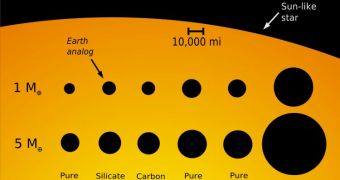Theoretical studies conducted by French investigators are suggesting that super-Earth-class extrasolar planets may not have magnetospheres shielding them from the harmful radiation their stars are releasing. As such, the development of alien life at this locations is improbable.
Super-Earths are a class of planets that are between 3 and 10 times more massive than Terra is. This puts them in an intermediary position, where they are neither Earth-sized, nor the size of a gas giant such as Jupiter or Saturn.
For quite some time now, astronomers have been hunting for as many of these objects as possible. Their efforts were driven by the belief that these objects are the most likely to holds alien life of all classes of exoplanets known to date.
Indeed, discovering second Earths is a very complex technical challenge, whereas hot Jupiters are generally too close to their parent stars to allow for water to exist in liquid form on their surface. Usually, temperatures reach thousands of degrees on their day sides.
But the new investigation shows that not even super-Earths can be seriously considered as important contenders in the race to find extraterrestrial life. Without a protective magnetic field surrounding them, life may never develop even if the seeds are there.
On Earth, the magnetosphere is produced by the dynamo effect, which in turn is created by a partially-molten planetary core. Due to their large mass, most super Earths probably feature solidified cores, which by definition cannot generate magnetic fields.
These conclusions belong to a team of investigators at the Institute of Mineralogy and Physics of Condensed Matter, in Paris, which was led by expert Guillaume Morard, Daily Galaxy reports.
An important effect that the lack of a magnetosphere would produce is that the atmosphere would no longer be protected from the influences of solar particles. Powerful solar winds would literally strip the atmosphere from around the planet, whisking it into space.
In other scenarios, it may be possible that super-Earths had a magnetosphere, but that they lost it along the way. In our own solar system, Mars is known for sure to have had such a protective shield. However, geological studies have determined that it shut down about 500 million years ago.
Of the 570+ exoplanets astronomers confirmed thus far, most are hot Jupiters – planets that orbit their parent stars closer than Mercury does around the Sun. A very select few are smaller than a gas giant, or located farther away from the star.

 14 DAY TRIAL //
14 DAY TRIAL //